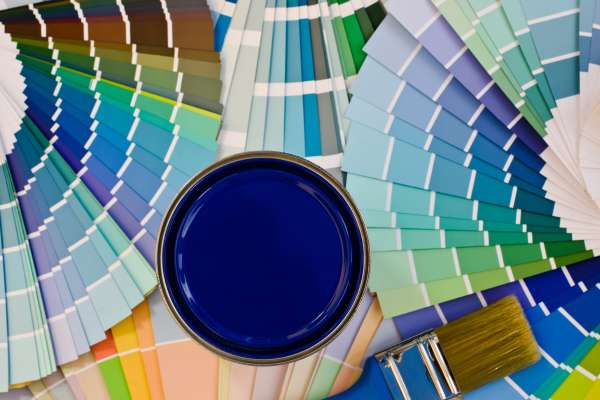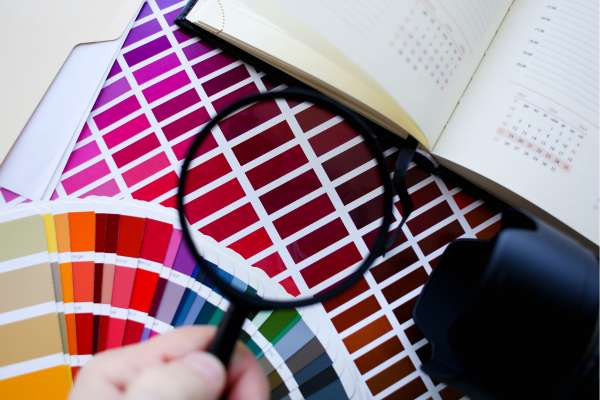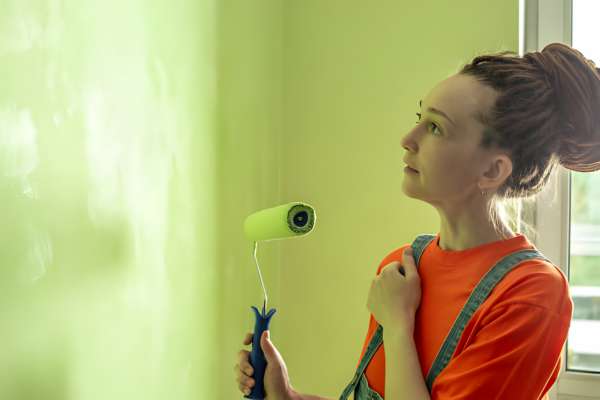Whether you’ve accidentally scuffed your wall or want to touch up an old paint job, achieving A flawless color match can sometimes feel like an elusive task. The last thing you want is A glaring patch of mismatched paint drawing attention to itself on an otherwise perfectly painted wall. But fear not, for in this article, we will guide you through the step-by-step process of how to expertly paint match a wall. From deciphering paint codes and selecting the right tools to blending techniques that ensure seamless transitions, prepare to unlock the secrets of achieving A harmonious And visually appealing finish for any wall in your home or office.
Does The Type Of Paint Affect The Color?
Certainly, The type of paint you choose can significantly affect the color of your wall. Different paint types like oil, latex, Or acrylic come with different finishes and might not dry to the same shade as they appear when wet. Additionally, The sheen level, such as matte, Satin, or gloss, can affect how light interacts with the color, Potentially altering its appearance. Quality also matters; higher-quality paints usually offer A truer shade payoff. When matching an existing shade, it’s crucial to use the same type of paint and finish for a uniform look. Consulting with A professional can guide you in making the best choice.
Can I Paint Match Any Color?
Theoretically, Paint matching any color is possible with the right tools And expertise. Modern color-matching technology allows for precise matching of colors through scanning And software algorithms. However, some intricate shades or those with unique undertones might be more challenging to match perfectly. Factors like the wall’s material, the lighting in the room, or even the age of the existing paint can alter the perception of the shade. In such cases, consulting with a paint specialist or using custom-mixed paints can increase accuracy. Remember, perfection might be elusive, but an expert match is usually achievable with effort and attention to detail.
Understanding The Basics Of Paint Matching
Paint matching is not just about selecting A similar shade from A color swatch. It involves A precise process of analyzing the original color and recreating it using A combination of pigments. Paint stores use special devices that scan A color sample and create custom-mixed paint that matches the original color. Understanding the basics of this process can help you appreciate the complexity of A perfect match. If you’re attempting a DIY project, you can utilize color-matching apps or take a chip to A professional for assistance. Investing time in understanding the underlying principles of paint match wall will ensure a more satisfying result and a cohesive visual appeal.
The Importance Behind Paint Matching
Paint matching is essential for maintaining the aesthetic consistency of A space, Especially when touching up existing paint or extending A color scheme. A perfect match ensures that repairs, Additions, Or changes blend seamlessly with the existing decor. An improper match, On the other hand, Can result in jarring transitions And visual discord. Whether you’re A homeowner looking to refresh A worn area or A professional aiming for A flawless finish, Tint matching is A critical skill. Understanding the importance of this process helps emphasize the need for precision and careful consideration in every painting project.
Preparing Fce Of Paint Matching
The face, Or surface, Preparation is A pivotal step in the paint-matching process. It involves cleaning, sanding, And priming the wall to ensure that the new paint adheres properly And the color matches accurately. Any imperfections or inconsistencies in the surface can lead to A mismatch between the new and existing paint. Proper preparation also prevents issues like peeling or chipping down the line. Investing time And effort in preparing the face of the wall is not just a prerequisite but A guarantee for A successful paint match.
The Science The Paint Match Process
Technology, chemistry, And exact mathematics are all used in the Tint-matching process, Which has Its roots in science. Modern color-matching technology converts the wavelengths of A hue into A pigmented formula after carefully analyzing them. By accounting for minute differences in tone and shade, This scientific approach guarantees that the colors are reproduced precisely. Understanding the physics behind color matching helps to demystify the procedure and makes It clear that It combines technology And art. It highlights the fact that color matching is A methodical, Accurate procedure that calls for meticulous execution rather than just guessing.
Identifying The Right Tools
Selecting the right tools is crucial for A successful paint match. This includes using appropriate brushes or rollers that provide the desired finish, Selecting the right type of Tint, and utilizing color-matching technology. Many stores offer devices that can scan A color sample and provide A matching color formula. For DIY enthusiasts, various apps and tools can assist in matching colors. Understanding And identifying the right tools is integral to the process, Ensuring that the match is not only visually perfect but also durable and consistent across different lighting and angles. It underscores the importance of not just the stain itself but the method and materials used to apply It. It highlights the fact that Tint matched is not only A matter of guessing but rather A systematic, Exact process that needs to be carried out with care.
Choosing The Right Paint Type
The type of paint used plays A crucial role in achieving A perfect match. Different paints have unique characteristics, including finish, Durability, And how they dry, All of which can affect the final appearance. Whether you choose oil-based, Latex, or acrylic Tint, The decision must align with the existing Tint type for a seamless match. The finish, Whether matte, Satin, or gloss, Should also be consistent with the original. Even the color’s undertones can differ between Tint types, So careful selection is paramount. Consulting with A color specialist or using color-matching technology can ensure that the chosen coloring type will align perfectly with your existing wall, Bringing coherence And beauty to your space.
Step-By-Step Guide To Paint Matching A Wall
Step 1: Collect A Paint Sample

Collecting a paint sample is crucial to match the existing wall color. You may use a small knife or scraper to carefully take a chip off the Tint from an inconspicuous spot. The chip should be large enough to analyze, usually about the size of a coin. Place the sample in a sealed container or bag, ensuring it doesn’t get scratched or damaged. If the area is too small to chip off, you may need to take a photo with good lighting for reference.
Step 2: Analyze The Paint Color

Analyzing the wall paint match color is the next critical step. You can take the sample to A Tint store where professionals use specialized machines to scan and identify the color precisely. These devices analyze the various color components and break them down into a specific code. The code is then cross-referenced with a database to find the exact match or equivalent. If using a photo, ensure the lighting conditions in the picture are similar to those in the shade store for an accurate analysis.
Step 3: Choose The Perfect Paint Match

Choosing the perfect Tint match is the final step. With the analyzed data, The color store will mix A custom Tint that matches the existing wall color. Always ask for A sample before purchasing, and test it on A hidden area to ensure a perfect match. Take into consideration the finish (matte, semi-gloss, etc.) to ensure the new color blends seamlessly with the existing wall. Patience is key in this step, as tiny variations in color can be noticeable once applied to the wall, so take the time to get it just right.
Step 4: Apply Your Paint

Applying the paint is A delicate process that requires attention to detail. Begin by cleaning the surface, And removing any dust or debris. Use painter’s tape to protect adjacent areas, And apply A primer if necessary. When ready, Use A quality brush or roller to apply the Tint evenly. Start with thin layers, letting each one dry before applying the next. Building up layers gradually helps achieve A consistent finish. Keep an eye on the edges, feathering them out to blend seamlessly with the existing Tint. Following these guidelines ensures a smooth application, Achieving A harmonious blend with the existing wall color.
Step 5: Evaluate The Results

Once the stain has dried, It’s time to evaluate the results. Examine the painted area under different lighting conditions, Including natural And artificial light, To make sure the color matches perfectly. Pay attention to how the new Tint interacts with the existing color, especially at the edges. If everything looks good, Remove the painter’s tape and clean up. Should you find any inconsistencies, You may need to apply additional coats or make adjustments accordingly. Remember, The goal is seamless integration with the existing wall color.
Troubleshooting Common Paint Matching Issues

Sometimes, Tint matching doesn’t go smoothly, and you may face issues like color discrepancies, uneven texture, or visible brush strokes. If the color is slightly off, re-analyze the Tint and consult with professionals. Uneven texture can be handled by proper surface preparation and applying the right number of coats. For visible strokes, focus on the proper brush or roller and technique. Investing in good quality tools and patiently building up thin layers can solve many of these issues. Each problem has a solution, and with careful examination and a methodical approach, you can overcome these obstacles to achieve a perfect color match.
How Do I Prevent Visible Paint Strokes When Paint Matching?
Preventing visible paint strokes requires both proper tools And technique. Choose high-quality brushes or rollers that are suitable for the Tint type. When applying the color, Use light, Even strokes, And avoid overloading the brush. Thin, multiple coats are preferable to one thick coat. Feather the edges to blend with the existing color. Let each layer dry completely before adding the next. These practices ensure smooth application without visible brush strokes. If needed, practice on a piece of cardboard or scrap wood to hone your technique. Being mindful of these aspects ensures a seamless and professional-looking finish.
Conclusion
Paint matching A wall is A nuanced challenge that calls for interest to element, endurance, And once in a while, A bit of trial and error. From gathering the proper sample to evaluating the very last consequences, Each step demands careful consideration. By understanding the ability problems And learning a way to prevent common troubles like seen Tint strokes, every body can reap a expert end result. Whether you are touching up a small place or repainting a larger section, this manual gives a comprehensive roadmap for a success coloration matching. Armed with those insights, you’re now prepared to take on your Tint-matching challenge with confidence and ability.
The complete procedure of color matching is defined in this manual, Providing A cohesive guide for both novice and experienced painters. By following the outlined steps, you’ll be nicely-geared up to tackle any shade-matching task, Ensuring A ideal and enjoyable end result. Happy portray!
